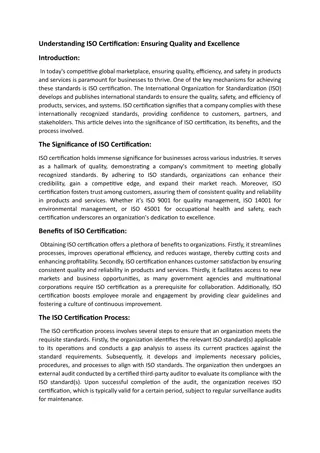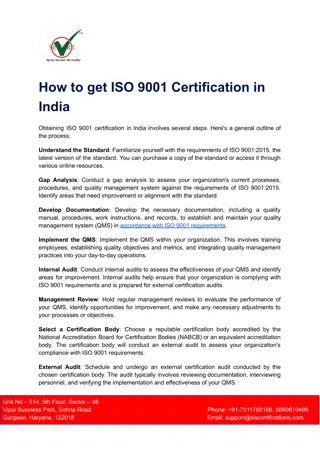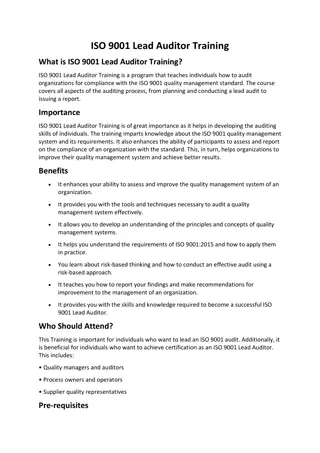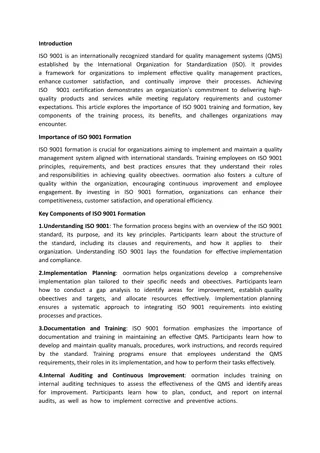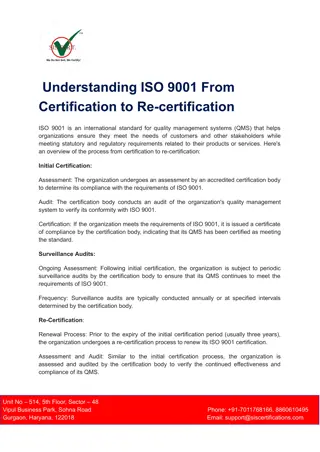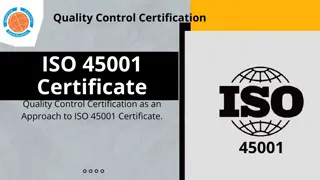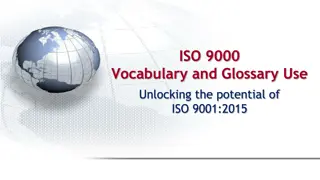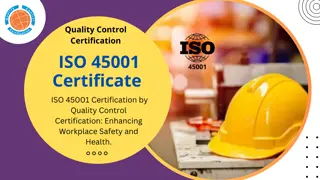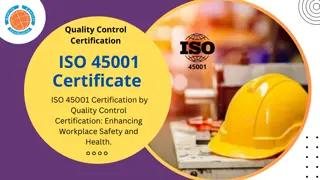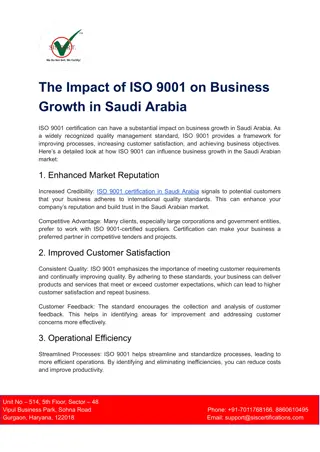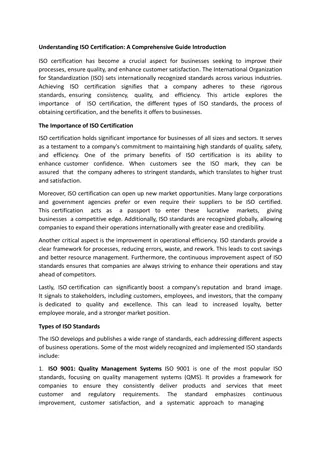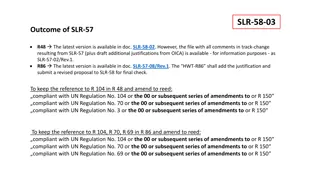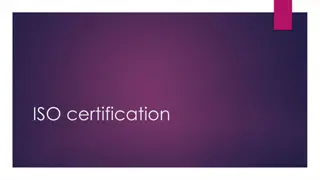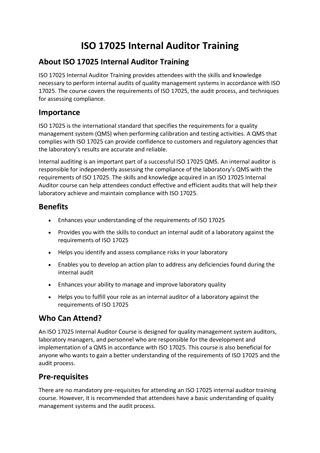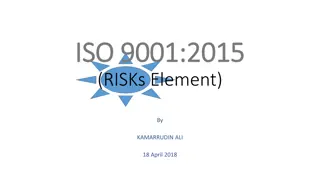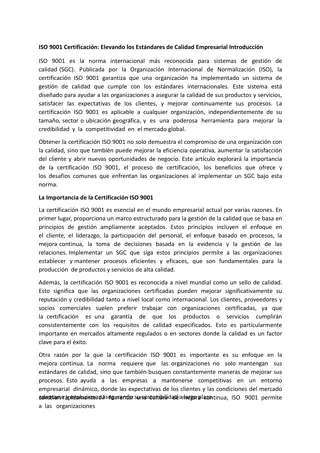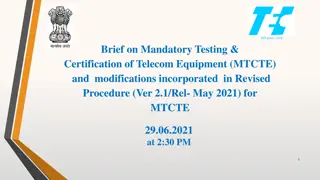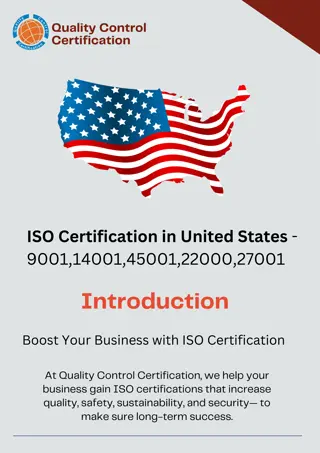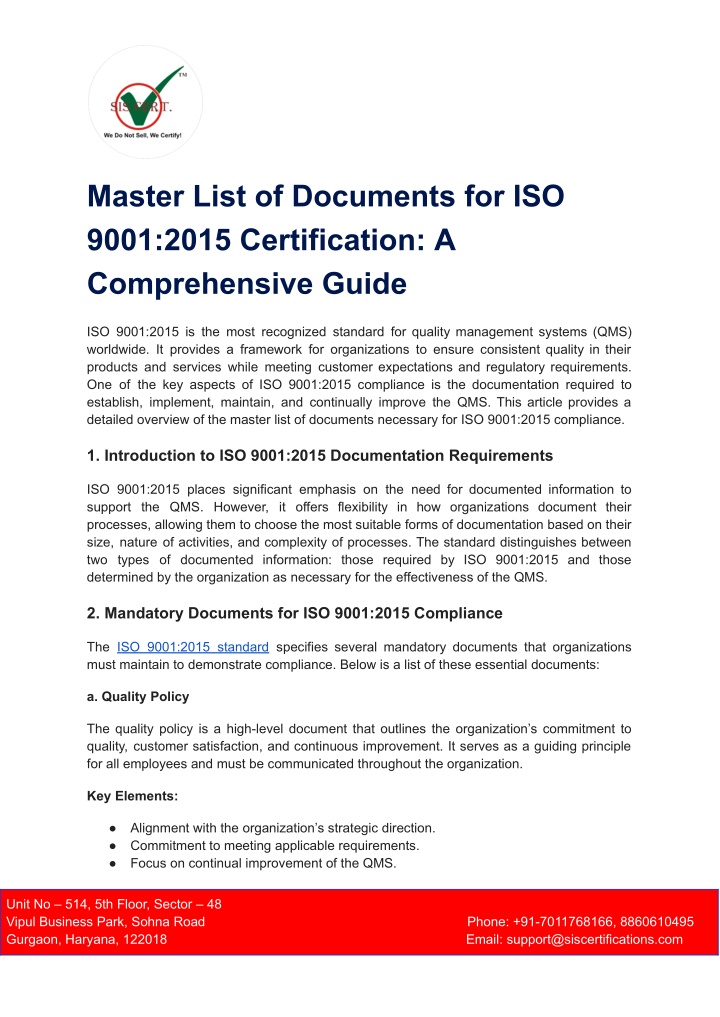
Master List of Documents for ISO 9001_2015 Certification
ISO 9001:2015 documentation is not just about fulfilling a requirement; it is about creating a structured approach to quality management that drives continuous improvement and operational excellence. By maintaining a comprehensive master list of docu
Download Presentation

Please find below an Image/Link to download the presentation.
The content on the website is provided AS IS for your information and personal use only. It may not be sold, licensed, or shared on other websites without obtaining consent from the author. If you encounter any issues during the download, it is possible that the publisher has removed the file from their server.
You are allowed to download the files provided on this website for personal or commercial use, subject to the condition that they are used lawfully. All files are the property of their respective owners.
The content on the website is provided AS IS for your information and personal use only. It may not be sold, licensed, or shared on other websites without obtaining consent from the author.
E N D
Presentation Transcript
Master List of Documents for ISO 9001:2015 Certification: A Comprehensive Guide ISO 9001:2015 is the most recognized standard for quality management systems (QMS) worldwide. It provides a framework for organizations to ensure consistent quality in their products and services while meeting customer expectations and regulatory requirements. One of the key aspects of ISO 9001:2015 compliance is the documentation required to establish, implement, maintain, and continually improve the QMS. This article provides a detailed overview of the master list of documents necessary for ISO 9001:2015 compliance. 1. Introduction to ISO 9001:2015 Documentation Requirements ISO 9001:2015 places significant emphasis on the need for documented information to support the QMS. However, it offers flexibility in how organizations document their processes, allowing them to choose the most suitable forms of documentation based on their size, nature of activities, and complexity of processes. The standard distinguishes between two types of documented information: those required by ISO 9001:2015 and those determined by the organization as necessary for the effectiveness of the QMS. 2. Mandatory Documents for ISO 9001:2015 Compliance The ISO 9001:2015 standard specifies several mandatory documents that organizations must maintain to demonstrate compliance. Below is a list of these essential documents: a. Quality Policy The quality policy is a high-level document that outlines the organization s commitment to quality, customer satisfaction, and continuous improvement. It serves as a guiding principle for all employees and must be communicated throughout the organization. Key Elements: Alignment with the organization s strategic direction. Commitment to meeting applicable requirements. Focus on continual improvement of the QMS. Unit No 514, 5th Floor, Sector 48 Vipul Business Park, Sohna Road Gurgaon, Haryana, 122018 Phone: +91-7011768166, 8860610495 Email: support@siscertifications.com
b. Quality Objectives Quality objectives are specific, measurable goals related to quality that the organization aims to achieve. These objectives must be consistent with the quality policy and should be established at relevant functions and levels within the organization. Key Considerations: Objectives should be SMART (Specific, Measurable, Achievable, Relevant, and Time-bound). Regular monitoring and review of objectives to ensure they are being met. c. Scope of the Quality Management System This document defines the boundaries and applicability of the QMS within the organization. It describes the scope of the QMS, including any exclusions from ISO 9001:2015 requirements and justification for those exclusions. Key Elements: Description of products and services covered by the QMS. Identification of processes included in the QMS. Justification for any exclusions from the standard s requirements. d. Process Documentation Organizations must document the processes required for the QMS, including their inputs, outputs, responsibilities, resources, and sequence of activities. This documentation is critical for ensuring consistency and control over the processes. Key Processes to Document: Product realization processes (e.g., design and development, production, service provision). Support processes (e.g., training, internal audits, document control). Management processes (e.g., management review, corrective actions). e. Documented Information Required by ISO 9001:2015 In addition to the specific documents mentioned above, ISO 9001:2015 requires organizations to maintain documented information as evidence of compliance with the standard s requirements. This includes: Unit No 514, 5th Floor, Sector 48 Vipul Business Park, Sohna Road Gurgaon, Haryana, 122018 Phone: +91-7011768166, 8860610495 Email: support@siscertifications.com
Records of Monitoring and Measurement: Records demonstrating that products and services meet specified requirements. Internal Audit Reports: Documentation of the results of internal audits, including findings and actions taken. Management Review Records: Records of management reviews, including decisions and actions related to the QMS. Records of Nonconformities and Corrective Actions: Documentation of nonconformities, actions taken to address them, and the effectiveness of those actions. 3. Additional Documents for Effective QMS Implementation While ISO 9001:2015 specifies certain mandatory documents, organizations may also find it beneficial to maintain additional documentation to ensure the effectiveness of their QMS. Some of these documents include: a. Work Instructions Work instructions provide detailed, step-by-step guidance for performing specific tasks or activities within the QMS. They are essential for ensuring that processes are carried out consistently and correctly. Key Features: Clear and concise instructions. Visual aids or diagrams to enhance understanding. Regular updates to reflect changes in processes or requirements. b. Forms and Templates Forms and templates standardize the documentation of information across the organization. They ensure that data is collected and recorded consistently, making it easier to analyze and review. Common Forms and Templates: Corrective action request forms. Audit checklists. Customer feedback forms. Training records. c. Risk Management Documentation Unit No 514, 5th Floor, Sector 48 Vipul Business Park, Sohna Road Gurgaon, Haryana, 122018 Phone: +91-7011768166, 8860610495 Email: support@siscertifications.com
ISO 9001:2015 emphasizes a risk-based approach to quality management. Organizations should document their risk management processes, including the identification, assessment, and mitigation of risks. Key Elements: Risk registers. Risk assessment methodologies. Records of risk treatment actions. d. Supplier Evaluation and Approval Records To ensure the quality of purchased goods and services, organizations should maintain records of supplier evaluations and approvals. This documentation is crucial for demonstrating that suppliers meet the organization s quality requirements. Key Aspects: Criteria for supplier evaluation. Records of supplier performance monitoring. Actions taken in response to supplier nonconformities. 4. Document Control and Maintenance Maintaining control over documented information is a critical aspect of ISO 9001:2015 compliance. Organizations must establish processes for controlling the creation, review, approval, distribution, and revision of documents. Effective document control ensures that employees have access to the most current and accurate information when performing their duties. Key Document Control Practices: Version Control: Assigning unique identifiers to document versions to track changes over time. Access Control: Ensuring that only authorized personnel can create, modify, or delete documents. Retention and Disposal: Establishing policies for the retention and secure disposal of obsolete documents. 5. Conclusion Unit No 514, 5th Floor, Sector 48 Vipul Business Park, Sohna Road Gurgaon, Haryana, 122018 Phone: +91-7011768166, 8860610495 Email: support@siscertifications.com
ISO 9001:2015 documentation is not just about fulfilling a requirement; it is about creating a structured approach to quality management that drives continuous improvement and operational excellence. By maintaining a comprehensive master list of documents, organizations can ensure that their QMS is effective, compliant, and capable of delivering consistent quality. Proper documentation provides the foundation for achieving ISO 9001:2015 certification, enabling organizations to enhance customer satisfaction, improve efficiency, and gain a competitive advantage in the market. Unit No 514, 5th Floor, Sector 48 Vipul Business Park, Sohna Road Gurgaon, Haryana, 122018 Phone: +91-7011768166, 8860610495 Email: support@siscertifications.com


